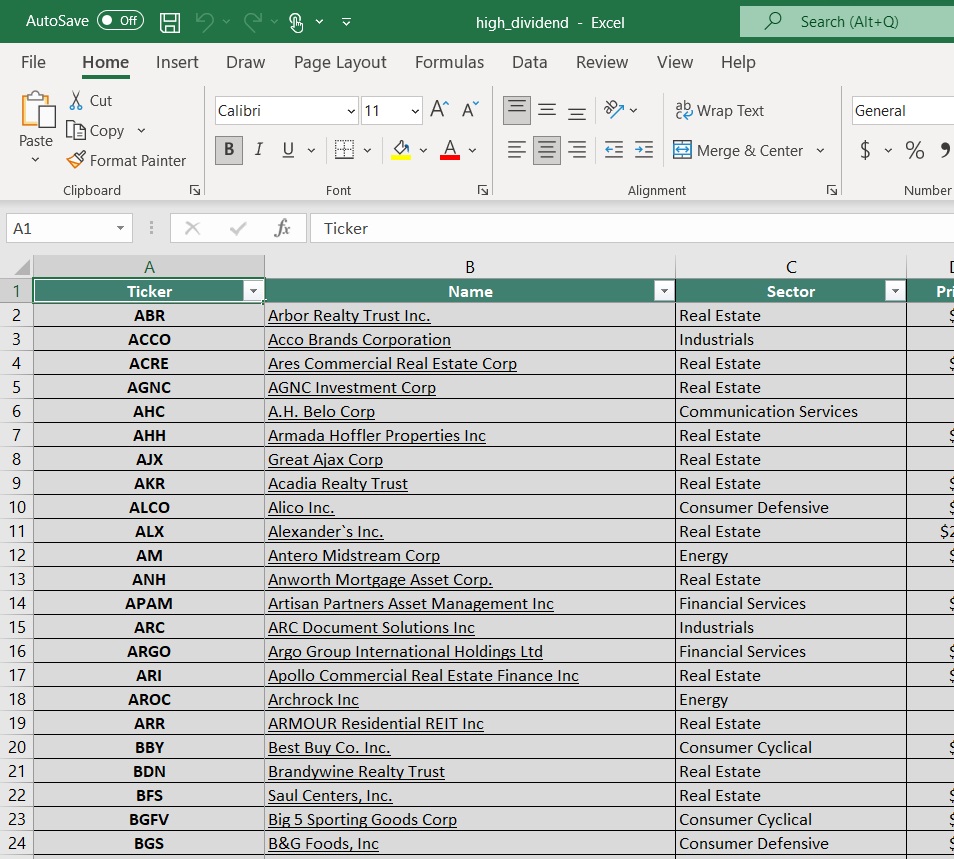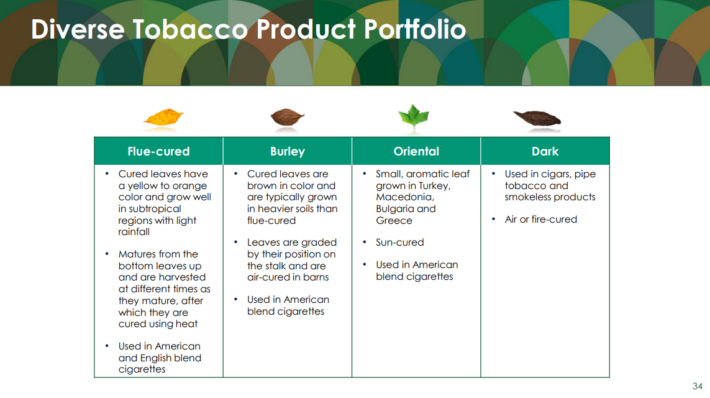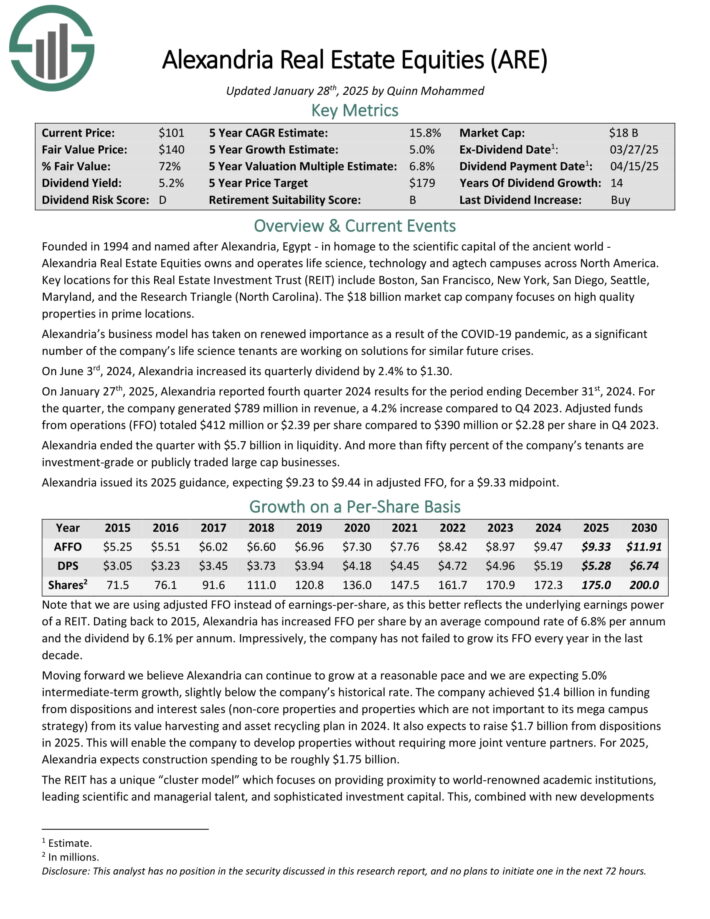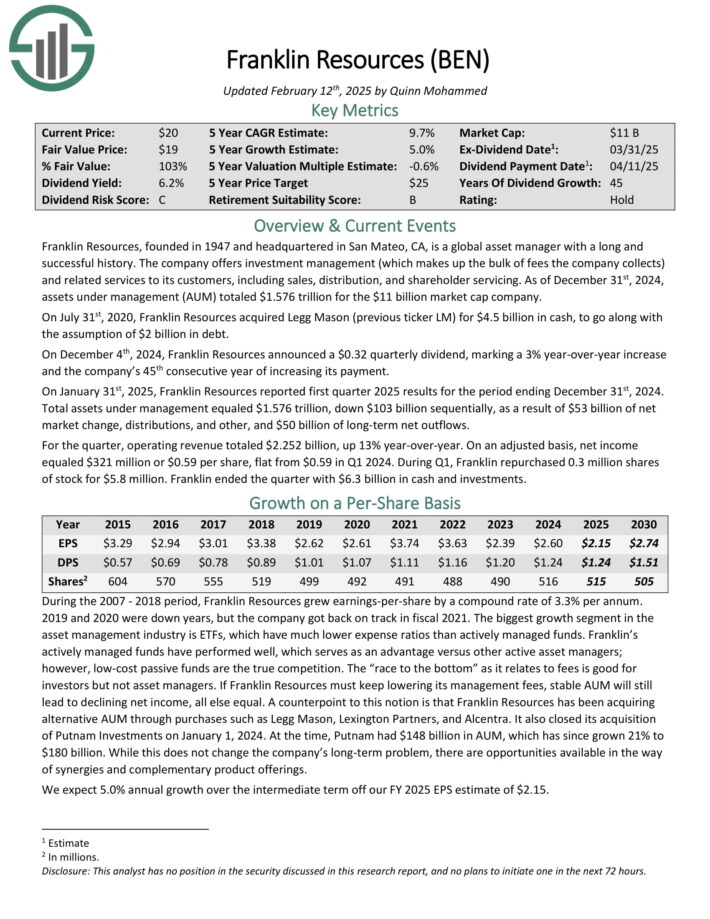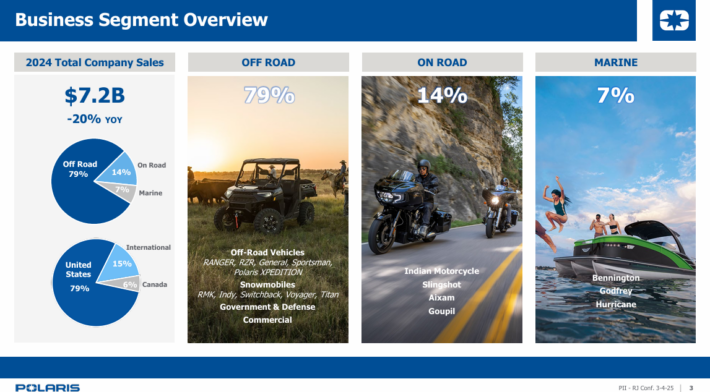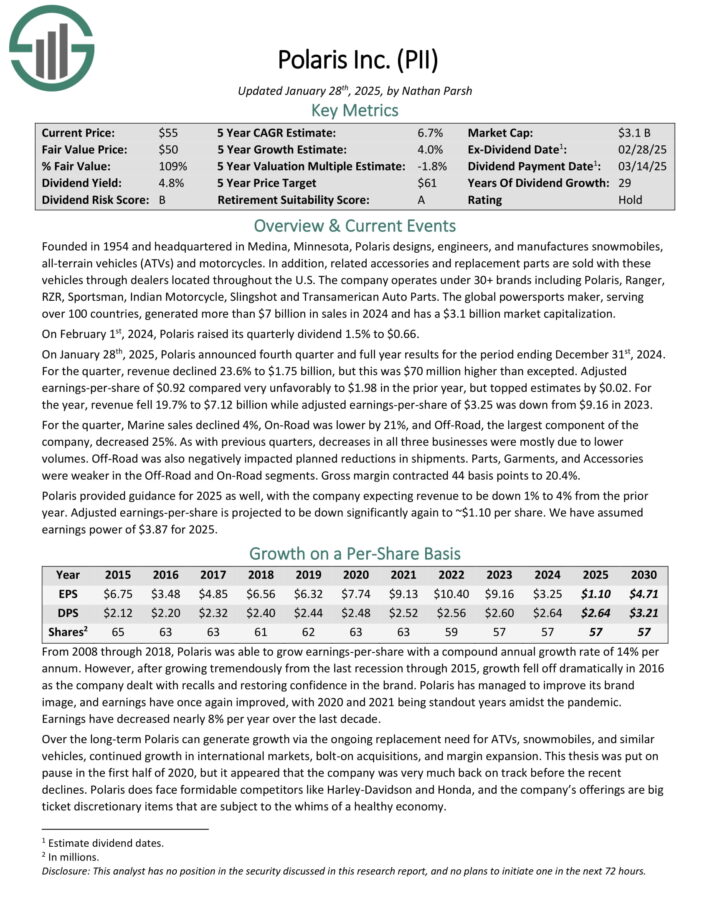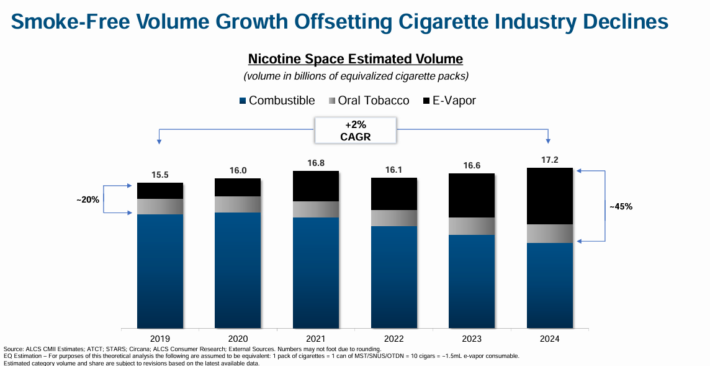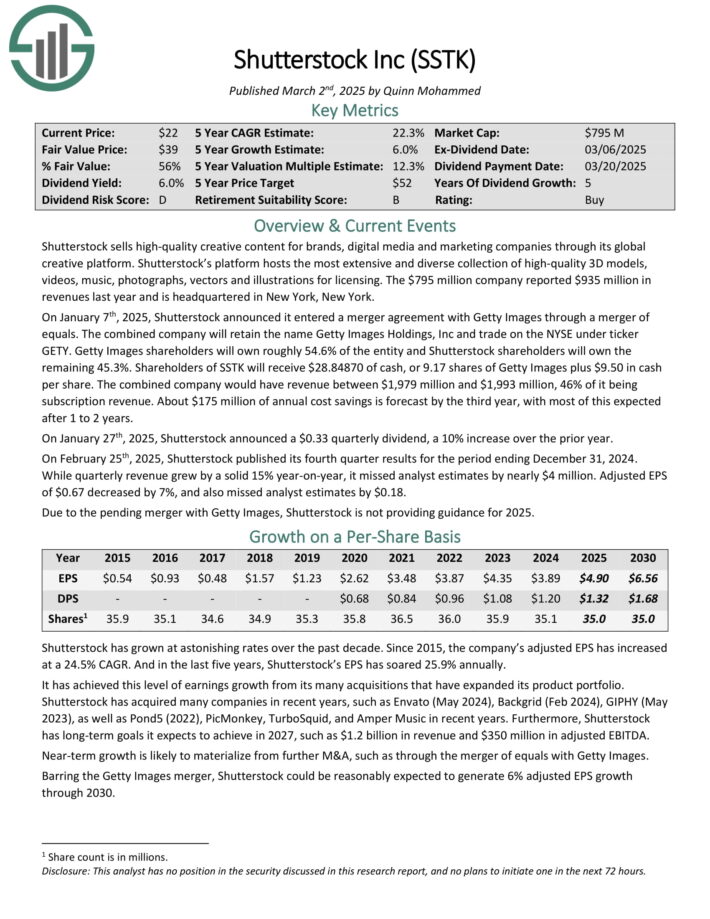Article updated on April 2nd, 2025 by Bob Ciura
Spreadsheet data updated daily
High dividend stocks are stocks with a dividend yield well in excess of the market average dividend yield of ~1.3%.
The resources in this report focus on truly high yielding securities, often with dividend yields multiples higher than the market average.
Resource #1: The High Dividend Stocks List Spreadsheet
Note: The spreadsheet uses the Wilshire 5000 as the universe of securities from which to select, plus a few additional securities we screen for with 5%+ dividend yields.
The free high dividend stocks list spreadsheet has our full list of ~140 individual securities (stocks, REITs, MLPs, etc.) with 5%+ dividend yields.
The high dividend stocks spreadsheet has important metrics to help you find compelling ultra high yield income investing ideas. These metrics include:
- Market cap
- Payout ratio
- Dividend yield
- Trailing P/E ratio
- Annualized 5-year dividend growth rate
Resource #2: The 7 Best High Yield Stocks Now
This resource analyzes the 7 best high-yield stocks in detail. The criteria we use to rank high dividend securities in this resource are:
- Is in the 870+ income security Sure Analysis Research Database
- Rank based on dividend yield, from highest to lowest
- Dividend Risk Scores of C or better
- Based in the U.S.
Additionally, a maximum of three stocks are allowed for any single sector to ensure diversification.
Resource #3: The High Dividend 50 Series
The High Dividend 50 Series is where we analyze the 50 highest-yielding securities in the Sure Analysis Research Database. The series consists of 50 stand-alone analysis reports on these securities.
Resource #4: More High-Yield Investing Research
– How to calculate your income per month based on dividend yield
– The risks of high-yield investing
– Other high dividend research
The 7 Best High Yield Stocks Now
This resource analyzes the 7 best high yielding securities in the Sure Analysis Research Database as ranked by the following criteria:
- Rank based on dividend yield, from highest to lowest
- Dividend Risk Scores of C or better
- Based in the U.S.
Note: Ranking data is from the current edition of the Sure Analysis spreadsheet.
Additionally, a maximum of three stocks are allowed for any single market sector to ensure diversification.
It’s difficult to define ‘best’. Here, we are using ‘best’ in terms of highest yields with reasonable and better dividend safety.
A tremendous amount of research goes into finding these 7 high yield securities. We analyze more than 850 income securities every quarter in the Sure Analysis Research Database. This is real analysis done by our analyst team, not a quick computer screen.
“So I think it was just looking at different companies and I always thought if you looked at 10 companies, you’d find one that’s interesting, if you’d look at 20, you’d find two, or if you look at 100 you’ll find 10. The person that turns over the most rocks wins the game. I’ve also found this to be true in my personal investing.”
– Investing legend Peter Lynch
Click here to download a PDF report for just one of the 850+ income securities we cover in Sure Analysis to get an idea of the level of work that goes into finding compelling income investments for our audience.
The 7 best high yield securities are listed in order by dividend yield below, from lowest to highest.
- High Dividend Stock #7: Universal Corp. (UVV)
- High Dividend Stock #6: Alexandria Real Estate Equities (ARE)
- High Dividend Stock #5: Enterprise Products Partners LP (EPD)
- High Dividend Stock #4: Franklin Resources (BEN)
- High Dividend Stock #3: Polaris Inc. (PII)
- High Dividend Stock #2: Altria Group (MO)
- High Dividend Stock #1: Shutterstock, Inc. (SSTK)
High Dividend Stock #7: Universal Corporation (UVV)
- Dividend Yield: 5.8%
- Dividend Risk Score: C
Universal Corporation is a market leader in supplying leaf tobacco and other plant-based inputs to consumer product manufacturers.
The Tobacco Operations segment buys and sells tobacco used to make cigarettes, cigars, pipe tobacco, and smokeless products.
Universal buys tobacco from its suppliers, processes it, and sells it to large tobacco companies in the US and internationally.
Source: Investor Presentation
The Ingredient Operations deal mainly with vegetables and fruits but is significantly smaller than the tobacco operations.
Universal Corporation reported its third quarter earnings results in February. The company generated revenues of $937 million during the quarter, which was more than the revenues that Universal Corporation generated during the previous period.
Revenues were positively impacted by product mix changes, while larger and better-yielding crops also had a positive impact on the company’s top-line. Universal Corporation’s revenues also rose on a year-over-year basis, showing a 14% increase.
Click here to download our most recent Sure Analysis report on Universal (preview of page 1 of 3 shown below):
High Dividend Stock #6: Alexandria Real Estate Equities (ARE)
- Dividend Yield: 5.8%
- Dividend Risk Score: C
Alexandria Real Estate Equities owns and operates life science, technology and ag-tech campuses across North America.
Key locations for this Real Estate Investment Trust (REIT) include Boston, San Francisco, New York, San Diego, Seattle, Maryland, and the Research Triangle (North Carolina). The company focuses on high quality properties in prime locations.
Alexandria’s business model has taken on renewed importance as a result of the COVID-19 pandemic, as a significant number of the company’s life science tenants are working on solutions for similar future crises.
On January 27th, 2025, Alexandria reported fourth quarter 2024 results for the period ending December 31st, 2024. For the quarter, the company generated $789 million in revenue, a 4.2% increase compared to Q4 2023.
Adjusted funds from operations (FFO) totaled $412 million or $2.39 per share compared to $390 million or $2.28 per share in Q4 2023.
Alexandria ended the quarter with $5.7 billion in liquidity. And more than fifty percent of the company’s tenants are investment-grade or publicly traded large cap businesses.
Alexandria issued its 2025 guidance, expecting $9.23 to $9.44 in adjusted FFO.
Click here to download our most recent Sure Analysis report on ARE (preview of page 1 of 3 shown below):
High Dividend Stock #5: Enterprise Products Partners LP (EPD)
- Dividend Yield: 6.3%
- Dividend Risk Score: B
Enterprise Products Partners was founded in 1968. It is structured as a Master Limited Partnership, or MLP, and operates as an oil and gas storage and transportation company.
Enterprise Products has a large asset base which consists of nearly 50,000 miles of natural gas, natural gas liquids, crude oil, and refined products pipelines.
It also has storage capacity of more than 250 million barrels. These assets collect fees based on volumes of materials transported and stored.
Source: Investor Presentation
Enterprise Products Partners reported strong fourth-quarter 2024 earnings, delivering $1.6 billion in net income, or $0.74 per common unit, representing a 3% increase over the prior year.
Adjusted cash flow from operations rose 4% to $2.3 billion, with the company declaring a quarterly distribution of $0.535 per unit, a 4% year-over-year increase.
Enterprise also continued its capital return strategy, repurchasing 2.1 million common units during the quarter and 7.6 million units for the full year, bringing total buybacks under its program to $1.1 billion.
For the full year, the company posted $9.9 billion in EBITDA, moving 12.9 million barrels of oil equivalent per day.
Click here to download our most recent Sure Analysis report on EPD (preview of page 1 of 3 shown below):
High Dividend Stock #4: Franklin Resources (BEN)
- Dividend Yield: 6.4%
- Dividend Risk Score: B
Franklin Resources is an investment management company. It was founded in 1947. Today, Franklin Resources manages the Franklin and Templeton families of mutual funds.
On January 31st, 2025, Franklin Resources reported net income of $163.6 million, or $0.29 per diluted share, for the first fiscal quarter ending December 31, 2024.
This marked a significant improvement from the previous quarter’s net loss of $84.7 million, though EPS remained lower than the $251.3 million net income recorded in the same quarter last year.
Source: Investor presentation
The past few years have been difficult for Franklin Resources. Franklin Resources was slow to adapt to the changing environment in the asset management industry.
The explosive growth in exchange-traded funds and indexing investing surprised traditional mutual funds.
ETFs have become very popular with investors due in large part to their lower fees than traditional mutual funds. In response, the asset management industry has had to cut fees and commissions or risk losing client assets.
Earnings-per-share are expected to decline in 2025 as a result. The company still maintains a manageable payout ratio of 51% expected for 2025, but if EPS continues to decline, the dividend payout could be in danger down the road.
Click here to download our most recent Sure Analysis report on BEN (preview of page 1 of 3 shown below):
High Dividend Stock #3: Polaris Inc. (PII)
- Dividend Yield: 6.5%
- Dividend Risk Score: B
Polaris designs, engineers, and manufactures snowmobiles, all-terrain vehicles (ATVs) and motorcycles. In addition, related accessories and replacement parts are sold with these vehicles through dealers located throughout the U.S.
The company operates under 30+ brands including Polaris, Ranger, RZR, Sportsman, Indian Motorcycle, Slingshot and Transamerican Auto Parts. The global powersports maker, serving over 100 countries, generated $7.2 billion in sales in 2024.
Source: Investor Presentation
On January 28th, 2025, Polaris announced fourth quarter and full year results. For the quarter, revenue declined 23.6% to $1.75 billion, but this was $70 million higher than excepted. Adjusted earnings-per-share of $0.92 compared very unfavorably to $1.98 in the prior year, but topped estimates by $0.02.
For the year, revenue fell 19.7% to $7.12 billion while adjusted earnings-per-share of $3.25 was down from $9.16 in 2023.
For the quarter, Marine sales declined 4%, On-Road was lower by 21%, and Off-Road, the largest component of the company, decreased 25%.
As with previous quarters, decreases in all three businesses were mostly due to lower volumes. Off-Road was also negatively impacted planned reductions in shipments. Parts, Garments, and Accessories were weaker in the Off-Road and On-Road segments.
Click here to download our most recent Sure Analysis report on PII (preview of page 1 of 3 shown below):
High Dividend Stock #2: Altria Group (MO)
- Dividend Yield: 6.9%
- Dividend Risk Score: B
Altria is a tobacco stock that sells cigarettes, chewing tobacco, cigars, e-cigarettes, and more under a variety of brands, including Marlboro, Skoal, and Copenhagen, among others.
With a current dividend yield of nearly 8%, Altria is an ideal retirement investment stock.
This is a period of transition for Altria. The decline in the U.S. smoking rate continues. In response, Altria has invested heavily in new products that appeal to changing consumer preferences, as the smoke-free category continues to grow.
Source: Investor Presentation
The company also has a 35% investment stake in e-cigarette maker JUUL, and a 45% stake in the Canadian cannabis producer Cronos Group (CRON).
Altria Group reported solid financial results for the fourth quarter and full year of 2024. For the fourth quarter, revenue of $5.1 billion beat analyst estimates by $50 million, and increased 1.6% year-over-year. Adjusted EPS of $1.29 beat by a penny.
For the full year, Altria generated adjusted diluted EPS growth of 3.4% and returned over $10.2 billion to shareholders through dividends and share repurchases.
For 2025, Altria expects adjusted diluted EPS in a range of $5.22 to $5.37. This represents an adjusted diluted EPS growth rate of 2% to 5% for 2025.
Click here to download our most recent Sure Analysis report on Altria (preview of page 1 of 3 shown below):
High Dividend Stock #1: Shutterstock, Inc. (SSTK)
- Dividend Yield: 7.1%
- Dividend Risk Score: B
Shutterstock sells high-quality creative content for brands, digital media and marketing companies through its global creative platform.
Its platform hosts the most extensive and diverse collection of high-quality 3D models, videos, music, photographs, vectors and illustrations for licensing. The company reported $935 million in revenues last year.
On January 7th, 2025, Shutterstock announced it entered a merger agreement with Getty Images through a merger of equals. The combined company will retain the name Getty Images Holdings, Inc and trade on the NYSE under ticker GETY.
Getty Images shareholders will own roughly 54.6% of the entity and Shutterstock shareholders will own the remaining 45.3%. Shareholders of SSTK will receive $28.84870 of cash, or 9.17 shares of Getty Images plus $9.50 in cash per share.
The combined company would have revenue between $1,979 million and $1,993 million, 46% of it being subscription revenue. About $175 million of annual cost savings is forecast by the third year, with most of this expected after 1 to 2 years.
On January 27th, 2025, Shutterstock announced a $0.33 quarterly dividend, a 10% increase over the prior year.
On February 25th, 2025, Shutterstock published its fourth quarter results for the period ending December 31, 2024. While quarterly revenue grew by a solid 15% year-on-year, it missed analyst estimates by nearly $4 million.
Adjusted EPS of $0.67 decreased by 7%, and also missed analyst estimates by $0.18.
Click here to download our most recent Sure Analysis report on SSTK (preview of page 1 of 3 shown below):
The High Dividend 50 Series
The High Dividend 50 Series is analysis on the 50 highest-yielding Sure Analysis Research Database stocks, excluding royalty trusts, BDCs, REITs, and MLPs.
Click on a company’s name to view the high dividend 50 series article for that company. A link to the specific Sure Analysis Research Database report page for each security is included as well.
More High-Yield Investing Resources
How To Calculate Your Monthly Income Based On Dividend Yield
A common question for income investors is “how much money can I expect to receive per month from my investment?”
To find your monthly income, follow these steps:
- Find your investment’s dividend yield
Note: Dividend yield can be calculated as dividends per share divided by share price - Multiply it by the current value of your holding
Note: If you haven’t yet invested, multiply dividend yield by the amount you plan to invest - Divide this number by 12 to find monthly income
To find the monthly income from your entire portfolio, repeat the above calculation for each of your holdings and add them together.
You can also use this formula backwards to find the dividend yield you need from your investments to make a certain amount of monthly dividend income.
The example below assumes you want to know what dividend yield you need on a $240,000 investment to generate $1,000/month in dividend income.
- Multiply $1,000 by 12 to find annual income target of $12,000
- Divide $12,000 by your investment amount of $240,000 to find your target yield of 5.0%
In practice most dividend stocks pay dividends quarterly, so you would actually receive 3x the monthly amount quarterly instead of receiving a payment every month. However, some stocks do actually pay monthly dividends.
You can see our monthly dividend stocks list here.
The Risks Of High-Yield Investing
Investing in high-yield stocks is a great way to generate income. But it is not without risks.
First, stock prices fluctuate. Investors need to understand their risk tolerance before investing in high dividend stocks. Share price fluctuations means that your investment can (and almost certainly will) decline in value, at least temporarily (and possibly permanently) do to market volatility.
Second, businesses grow and decline. Investing in a stock gives you fractional ownership in the underlying business. Some businesses grow over time. These businesses are likely to pay higher dividends over time.
The Dividend Champions are an excellent example of this; each has paid rising dividends for 25+ consecutive years.
What’s dangerous is when a business declines. Dividends are paid out of a company’s cash flows. If the business sees its cash flows decline, or worse is losing money, it may reduce or eliminate its dividend.
Business decline is a real risk with high yield investing. Business declines often coincide with and or accelerate during recessions.
A company’s payout ratio gives a good gauge of how much ‘room’ a company has to pay its dividend. The payout ratio is calculated as dividends divided by income.
The lower the payout ratio, the better, because dividends have more earnings coverage.
A company with a payout ratio over 100% is paying out more in dividends than it is making in profits, a long-term unsustainable situation.
For example, a company with a payout ratio of 50% is making double in income what it is paying out in dividends, so it has ‘room’ for earnings to decline significantly without reducing its dividend.
Third, management teams can change their dividend policies. Even if a company isn’t declining, the company’s management team may change priorities and reduce or eliminate its dividend.
In practice, this typically occurs if a company has a high level of debt and wants to focus on debt reduction. But it could in theory happen to any dividend paying stock.
The risks of high yield investing can be reduced (but not eliminated) by investing in higher quality businesses in a diversified portfolio of 20 or more stocks.
This reduces both business decline risk (by investing in high quality businesses) and the shock to your portfolio if any one stock does reduce or eliminate its dividend (through diversification).
Other High Dividend Research
The free spreadsheet of 5%+ dividend yield stocks in this article gives you more than 140 high yield income securities to review. You can download it below:
Investors should continue to monitor each stock to make sure their fundamentals and growth remain on track, particularly among stocks with extremely high dividend yields.
See the resources below to generate additional compelling investment ideas for dividend growth stocks and/or high-yield investment securities.
- Dividend Kings: 50+ years of rising dividends
- Dividend Aristocrats: 25+ years of rising dividends and in the S&P 500
